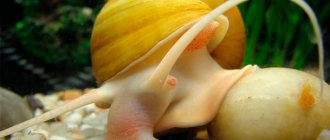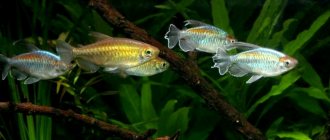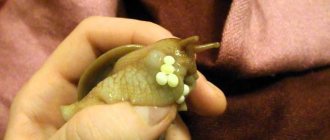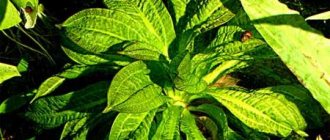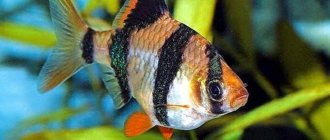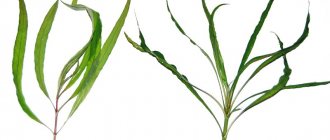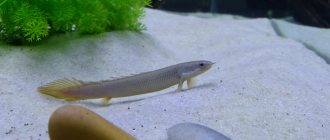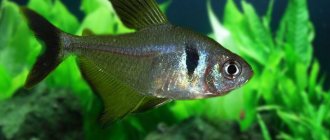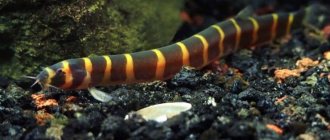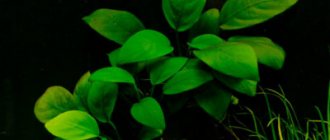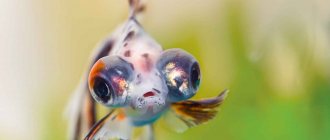Description
The length of the fish does not exceed 5 cm. It is popular due to the unusual color of its scales.
External characteristics of an adult:
- body elongated, laterally flattened;
- the scales on the body are silver-gray and can shimmer pink or golden;
- the fins are transparent, the tail has a forked shape;
- The dorsal and caudal fins are orange, but come in red, brick, beige, and olive colors.
The main feature in the description of appearance is black wedge-shaped spots on the sides, elongated towards the tail.
In addition to cuneiform rasbora, there are:
- rasbora espei - smaller (up to 3.5 cm), with copper-colored scales, with a narrow black spot concave on the underside;
- Hengel's rasbora is as small as Espei's rasbora, with a pale yellow body color, with a bright orange spot bordered by a black spot on top and in front;
- Rasbora somphongsi is the smallest representative of the genus (length up to 3 cm), with a narrow black stripe.
Appearance
The wedge-spotted fish is sometimes confused with other rasboras (there are about 50 species), but although the appearance and some habits are somewhat similar, there is a main difference - the wedge-shaped eggs are glued to plants, and are not simply thrown into the water.
Heteromorphs are very small fish, with a long, high body , slightly flattened on the sides. They attract attention with their interesting color: against the general background of a pinkish or copper color (sometimes red, beige or yellow-green), lateral triangular spots of blue or black color, similar in shape to a wedge, stand out (hence the name of the species). The belly is silvery, the caudal and dorsal fins are orange or bright pink, and the rest are pale crimson.
The shape and size of wedge-shaped spots in females and males differ: in females the spot is very short and the lower corner is rounded, while in males the spot is sharp and long, extending to the anal fin.
Care and maintenance
Rasbora is unpretentious. An aquarium with a volume of up to 50 liters is enough for a small flock; for a large flock, a tank of up to 100 liters is selected. Representatives of the species are active and capable of jumping out of the water, which is why the aquarium is equipped with a lid.
The optimal number of individuals in a school is 6 – 7. The fish cannot stand living alone, becomes shy, and loses its color saturation.
Water parameters
Mandatory aquarium equipment is a filter and an aerator. Pets should not experience air deficiency. You should not take a powerful filter, since in the natural reservoirs where rasboras live, the current is not strong.
Optimal water parameters:
- temperature – 23 – 25°C;
- acidity – 5.5 – 7.0 pH;
- hardness – 8 – 12 dH.
Lighting
Diffused lighting of moderate intensity is created (up to 8 hours a day). To dim the light, you can use floating plants: duckweed, Java moss. It is advisable to make the background of the aquarium dark.
Vegetation
It is recommended to choose plants that grow in the rasbora's natural habitat:
- hygrophila;
- aquatic ferns;
- blue;
- cryptocoryne;
- hornwort.
Vegetation is planted abundantly, but in the peripheral zone of the tank, so that the fish have enough space to swim. If pets are cramped, they will become fearful and irritable.
Priming
It is advisable to take fine sand and small pebbles. You should not use colored soil: it can harm small fish.
Decor
The best decor option when setting up an aquarium is medium-sized driftwood.
Keeping in an aquarium
Keeping and caring for rasboras in an aquarium will not cause much trouble even for a novice aquarist. The fish, despite its miniature size, loves space and being kept in schools, so the volume of the tank should be at least 50 liters of water for a group of 10–15 individuals. The artificial pond is equipped with a lid or mesh on top to prevent moving pets from leaving the water space.
Water indicators in the aquarium:
- hardness – 4–15 dH;
- acidity – 6 – 7.5 pH;
- temperature – 25C.
The green-eyed rasbora comes from countries with a mild, warm climate, so low temperatures in the aquatic environment will kill the pet. In winter, experienced aquarists recommend acquiring a heater and thermometer to control the temperature.
If you plan to breed cuneiform rasbora in an artificial reservoir, then you cannot do without a filter. Mechanical filtration is installed in the aquarium, and the water is renewed weekly, replacing 30% of the volume.
The rasbora aquarium fish prefers dim lighting, even slightly darkened. At home, the phenotype lives in rivers and lakes, where sunlight is obscured by dense tree crowns - hence the fish’s love for dim light. The soil is chosen in a dark color, and the vegetation is planted in a dense layer. Decorations must be placed in the tank: shelters, grottoes and caves, since the species are shy and cautious. An algae-free area is left for feeding and swimming.
Compatibility and Behavior
Rasbora heteromorph is an active, mobile aquarium fish that prefers to swim in the upper and middle layers of water. Behavior is friendly.
This is an ideal pet for a community aquarium and can easily coexist with other peaceful species. Excellent compatibility with:
- neon;
- erythrozonus;
- pristellas.
A small and defenseless rasbora cannot be housed with large predators: for them it will become food.
Heteromorph
Heteromorph rasbora has a lot of other names: cuneiform or wedge-shaped rasbora, harlequin. Its natural habitats are the rivers and streams of Thailand, Malaysia and Indonesia. This rasbora is recommended for beginning aquarists as it is a peaceful and unpretentious creature.
The distinctive features of this fish are dark purple triangles on the sides and large black eyes with a red and yellow outline. The body color is silvery-green or golden, and there is an orange spot on the dorsal fin. The anal and pectoral fins are transparent, the caudal fins are deeply cut. Body dimensions reach up to 5 cm.
The body is flattened on the sides, in females the abdomen is fuller, and the triangular pattern is not sharp and reaches only half of the body. In males, the spot is pointed and stretches to the edge of the abdomen.
Heteromorph
Care
The fish keep in a school of at least 8 individuals. Rasbora cuneiformis looks especially impressive against the background of dark soil with various types of cryptocoryne.
The holding capacity should be at least 50 liters with free space for swimming. Rasboras prefer water mixed with peat extract, soft and settled for 3-4 days at a temperature of 23-25°C, acidity 6-8, hardness up to 9°. Filtration and water changes are required. The soil can be small pebbles, sand, gravel. It is necessary to have islands densely planted with plants. Fish are susceptible to bacterial infections in dirty water.
Rasboras feed on live food of suitable size. You can feed it with white bread and semolina.
Reproduction
Beginner aquarists can breed this rasbora. Rasbora heteromorph reaches sexual maturity at 8-10 months, females mature earlier. To avoid unsuccessful spawnings, spawners are selected from 2 years old.
Spawning is possible in pairs or in groups; it is advisable to keep females separate from males for 1-2 weeks. For pair spawning, a 5-liter container is suitable, and for group spawning, a 40-liter container with a separator mesh at the bottom. Temperature 27-28°C, hardness 4-7°, acidity 6.5. The spawning ground is planted with Ludwigia, Aponogeton and Cryptocoryne plants.
During paired spawning, females lay up to 300 eggs on plants; after the courtship dance, the male fertilizes the eggs. After spawning, the spawners are removed, the larvae appear on the 2nd day, and after 5 days the rasbora fry emerge. They are fed ciliates, Artemia nauplii, and rotifers. The fry grow quickly and at the age of 1 month they develop a distinctive triangle.
Return to content
Breeding and reproduction
Breeding rasbora at home is not an easy task. Spawning becomes possible under certain water parameters: hardness up to 2 dH, temperature 26 – 28°C. Broad-leaved plants must be placed in the spawning aquarium.
For breeding, 9-12 month old individuals are selected: in a flock there should be two males per female. Potential parents are fed high quality live food. They move to the spawning area in the evening, and in the morning the males drive the females to secluded places under the plants.
The female lays eggs under the leaves, and the male fertilizes them. Spawning duration is up to 2 hours. After the process is completed, the adults are removed, as they can eat the hatching offspring.
The fry appear within a day and swim a week later. They feed on small food, such as ciliates.
Diet
Picky fish eat absolutely all types of dry, live and frozen food. Nutrition should be balanced. Adult fish are fed 1-2 times a day, the remaining food is removed 5 minutes after it is served. Overfeeding is not recommended, as it may cause health problems later.
Feeding the fry
For the first 5 days, babies feed from the yolk sac. After its resorption, the fry are fed with live dust, ciliates or rotifers. In the absence of live food, you can give hard-boiled and mashed egg yolk.
Diseases and prevention
The most common diseases are caused by poor quality fish care and improper maintenance of the aquarium:
- Cold. Occurs when the water temperature drops. The fish lose activity, do not eat anything, and their gills swell. Prevention – maintaining normal temperature.
- Fungus. A whitish rot appears on the fins. For treatment, a sick individual is dipped into a container with potassium permanganate dissolved in water for 5 days for 10 minutes (a tablespoon per liter).
- Velvet disease. The body of the fish is covered with a golden coating. Pets die. The antibiotic Bicillin-5 is used for treatment. A preventative measure is good aeration.
How long rasboras live is determined by the conditions of detention. The average life expectancy is 4 years.
Rasbora wedge-shaped is a cute fish that looks impressive in an aquarium of any size. It is recommended for beginners to start it, as there are no difficulties in caring for it.
Breeding Rasbora cuneiformis
When breeding cuneiform rasbora, certain difficulties may arise. In order to avoid them, you should first of all pay attention to the conditions of keeping the species, since successful breeding largely depends on the training of the producers.
To do this, you should purchase at least two groups of unrelated fry. It is desirable that the fish in different schools differ in age by two to three months. It is better to keep flocks in different aquariums.
Females of cuneiform-spotted rasboras reach maturity somewhat earlier than males and, at the age of 6-7 months, are already trying to initiate mating games. Having straightened their fins, they position themselves on the side of the males, thereby inviting them to take part in the game. In the finale, after swimming under a leaf of a plant, the female turns upside down, simulating the process of laying eggs (in the absence of suitable plants, the walls of the aquarium can be used).
Males of the same age are not yet ready to breed. Sometimes they participate in such games, but at this age there will be no caviar from such a pair. Males become sexually mature at the age of 8-9 months, during this period they are leaner and brighter colored than females.
It is recommended to plant future producers in different containers for 7-10 days. In this case, the temperature is maintained at 23-24°C. All this time they are fed abundantly with cyclops, small bloodworms, enchitraea or grindal. They should be given crushed wheat germ as a plant food rich in vitamin E.
Three quarters of the volume of the spawning tank is filled with old water from the aquarium with an established biological equilibrium, having previously passed it through activated carbon. The remaining part of the volume is filled with settled distilled or osmotic water, reducing the overall hardness to 2-5° (in harder water the eggs partially lose their stickiness). It is preferable to obtain the required acidity (pH 6-6.5) using alder cones or peat decoction rather than using ortho-phosphoric acid. The water should turn the color of weakly brewed tea. The air compressor must operate around the clock.
Wedge-spotted rasboras
A week before the scheduled spawning, a heater is placed in the spawning tank, plants are placed and a separator net is installed. Manufacturers glue the main part of the eggs to the underside of the leaves, but some of it sinks to the bottom of the aquarium and, in the absence of a separator net, this part of the eggs will be eaten.
The Thai fern is best suited as a spawning substrate, as it is quite tolerant of a lack of light and serves as a good indicator of the water quality in the spawning area.
It should be noted that damaged leaves of the Thai fern release toxic substances into the water, which can not only destroy the eggs, but also prevent the start of spawning.
The volume of the spawning tank is chosen depending on the number of producers. Both pair and school spawning are possible. In the first case, a container with a volume of 6-8 liters is sufficient, while in the second, for 8-10 individuals, a spawning tank with a volume of at least 15-20 liters will be required.
It is better to launch the spawners into the spawning area in the evening, shortly before turning off the lights, after feeding them for the last time in the morning.
If there are several pairs of manufacturers, then it is better to leave one or two pairs in reserve. The temperature in the spawning tank is gradually raised to 26-27°C. Aeration is reduced or temporarily turned off.
Spawning usually occurs the next day, but may delay for one or even two days. The reasons for such delays are different: unpreparedness of manufacturers, inappropriate composition of water, its temperature and even atmospheric pressure. In inclement weather, with low atmospheric pressure, fish, as a rule, do not spawn.
If spawning does not occur within 2-3 days, you should try to stimulate it. There are several ways to do this: firstly, you can try to change the male, and secondly, replace part of the water with water of the same composition, but at a higher temperature (1-2°C). But perhaps the most effective remedy is adding water (0.5-1 liter) from the aquarium where spawning recently occurred.
The initiator of spawning is usually the female, after which the initiative passes to the male. During the rut, the female finds the most suitable area on the plant leaf for laying eggs, after which she turns upside down and glues the eggs to the underside of the leaf. The male, bending around the female's body, fertilizes the eggs with milk. The female lays no more than 10 eggs at a time. Not all eggs stick to the leaf. Some of them sink to the bottom, sticking to the mesh. It is very rare, but it happens that cuneiform rasboras lay eggs on the walls of the aquarium.
During pair spawning, the egg yield is significantly less than during group spawning. Not all females often take part in school spawning, but only those whose eggs are better matured. Such females are pursued by males first. Males also do not all take part in spawning. Those males who do not participate in the fertilization of eggs, as a rule, are engaged in eating them.
Spawning of cuneiform rasbora
During group spawning, inactive males and females that have not collected eggs, if there is a reserve, are replaced. At this point, producers are so engrossed that they hardly notice outside interference unless it lasts too long.
Newly planted fish soon become accustomed and join the spawning process, which lasts about 2-2.5 hours. During this period of time, a good pair of breeders can lay up to 200 eggs.
At the end of spawning, while waiting for the result, the producers are again seated in different aquariums. In this case, it is recommended to drain the remaining eggs from the females. This is done very carefully: without removing the fish from the wet net or wrapping it in wet cotton wool, hold it with one hand with its head towards you, and with the other, with a wet cotton swab, draw it along the abdomen from head to tail. This procedure should be done for one minute, making sure that the gills of the fish remain moist.
Female cuneiform-spotted rasboras are predisposed to what is called spawning. Therefore, from time to time, even if getting offspring is not part of your plans, fish must be placed for spawning so that a cyst does not form. Females with advanced cysts die.
The caviar of cuneiform rasboras is not afraid of light, but it is still better to avoid bright lighting. If aeration was turned off during spawning, then it should be turned on; air bubbles mixing the water provide a flow of oxygen to the eggs.
Sometimes, immediately after spawning, all laid eggs turn white. This happens if the selection of sires is unsuccessful (either the female’s eggs are overripe, or the male is not active enough).
It also happens that caviar, at first transparent, turns white after some time, and then completely dissolves. This may be due to unsuitable water composition.
A third option is also possible: when part of the caviar is transparent and part is white, and the ratio between them can be different. If you come across transparent eggs among the whitened eggs, then it makes sense to drain some of the water into another container and place there the plant with the eggs deposited on the leaves. Live eggs that have fallen to the bottom are also transferred there, being collected with a thin glass tube.
If there is not enough whitened caviar, you should add methylene blue to the water until it turns light blue.
A day later, rather large yellowish larvae hatch from the eggs. They hang on the walls of the aquarium, the leaves of plants, or lie on the bottom. Shaking slightly, you need to carefully remove the fern and separator net from the aquarium, and to prevent the water from spoiling, two or three coil snails are planted there, which quickly eat the dead eggs. It is advisable to reduce the water level to 5-7 centimeters. A day before the larvae swim (four days after spawning), you can add some ciliates and rotifers into the aquarium. The fry that swim the next day are immediately able to take artemia nauplii, and the protozoa will serve as good feeding, since artemia nauplii do not live long in fresh water.
To maintain cleanliness in the container with fry, you can use the following method. The water along with the larvae is carefully poured into a round enamel bowl, after which it is spun. After the water stops and the fry spread throughout the volume, the debris will remain in the center, from where it can easily be collected with a blower or collected with a hose with a thin tube.
While the fry are in the bowl, the aquarium should be rinsed thoroughly without using chemical detergents. Then carefully pour the water with the fry into it, adding a little harder water of the same temperature. After these procedures, the fry should be fed.
The fry tolerate such operations well. With proper care they grow quite quickly. Two weeks after they swim, dark spots appear on their sides, and a black rim appears at the base of the caudal fin. After another ten days, the fry take on small daphnia.
You should not feed the fry with small cyclops: if it gets into the aquarium in large quantities, it can cause significant damage to the fry.
Only at one month of age, when the fry are strong enough, can they be given these crustaceans in small quantities. Once the fry reaches one and a half centimeters, finely chopped tubifex can be included in their diet, in small quantities. After such an addition to the diet, the growth of juveniles noticeably accelerates.
The growth rate is also affected by the volume of the aquarium. Already two to three weeks after the fry swim, they should be transferred to a larger aquarium with round-the-clock water aeration. For filtration, it is better to use a foam filter.
At four months of age, in young males of cuneiform rasbora, the black spot begins to elongate in its lower anterior part, and by 6-7 months the process stops at the level between the pectoral and ventral fins. In addition to this feature, males are characterized by a slender body, wider pelvic fins and bright coloring of the dorsal and caudal fins.
